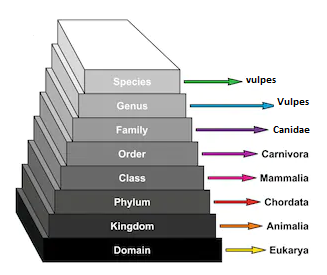
The correct sequence of taxa in the animal kingdom is-
(A) Kingdom, Phylum, Class, Order, Family, Species, and Genus
(B) Kingdom, Phylum, Class, Order, Family, Genus, and Species
(C) Kingdom, Phylum, Class, Family, Order, Species, and Genus
(D) Phylum, Kingdom, Class, Family, Order, Genus, and Species
Answer
580.5k+ views
Hint: Kingdom Animalia is the largest of the five existing kingdoms on Planet Earth. The scientific classification system is divided into seven major groups,
(1) kingdom,
(2) phylum or division,
(3) class,
(4) order,
(5) family,
(6) genus, and
(7) species.
Complete answer:
The Kingdom is the largest group and the smallest species. The word phylum is used in the animal kingdom, and it is the second-largest group.
In a division or phylum, the classes have more common characteristics than the animals. For example, the phylum Chordata includes amphibians, reptiles, and birds. But each of the animals belongs to another class. Amphibians belong to the Amphibian class that consists of frogs, toads, and salamanders. Reptiles belong to the Reptilia class that consists of snakes, crocodiles, and alligators. Birds are in the Aves genus.
An order is made up of animals that have more characteristics than those in a class. Every animal in the Mammalia class produces milk for its young. These mammals include cats, pigs, raccoons, and shrew. The dogs, cats, and raccoons consume meat and are grouped with other food-eating species in an order called Carnivora.
A family is made up of animals that are even more alike to those in order.
Carnivora is both in order of wolves and cats. Yet wolves are a member of the Canidae family and cats belong to the Felidae family
A genus is made up of animals with very similar groups but usually, members of different groups can not breed with each other.
Both the timber wolf and the coyote belong to the family Canis. But, in general, coyotes and timber wolves do not breed with each other.
The fundamental units of scientific classification are genus. Animals in a genus have very common features and habits but vary in one respect or another from other types of life. Group: One scientific name is assigned to each individual of a group.
So, the option (B) is correct

Fig. The sequence of Animal Kingdom
Note: One of the most fundamental forms of classification of animals is the presence or absence of the notochord. Hence, two major groups exist, namely:
Chordates and Non-chordates.
(1) kingdom,
(2) phylum or division,
(3) class,
(4) order,
(5) family,
(6) genus, and
(7) species.
Complete answer:
The Kingdom is the largest group and the smallest species. The word phylum is used in the animal kingdom, and it is the second-largest group.
In a division or phylum, the classes have more common characteristics than the animals. For example, the phylum Chordata includes amphibians, reptiles, and birds. But each of the animals belongs to another class. Amphibians belong to the Amphibian class that consists of frogs, toads, and salamanders. Reptiles belong to the Reptilia class that consists of snakes, crocodiles, and alligators. Birds are in the Aves genus.
An order is made up of animals that have more characteristics than those in a class. Every animal in the Mammalia class produces milk for its young. These mammals include cats, pigs, raccoons, and shrew. The dogs, cats, and raccoons consume meat and are grouped with other food-eating species in an order called Carnivora.
A family is made up of animals that are even more alike to those in order.
Carnivora is both in order of wolves and cats. Yet wolves are a member of the Canidae family and cats belong to the Felidae family
A genus is made up of animals with very similar groups but usually, members of different groups can not breed with each other.
Both the timber wolf and the coyote belong to the family Canis. But, in general, coyotes and timber wolves do not breed with each other.
The fundamental units of scientific classification are genus. Animals in a genus have very common features and habits but vary in one respect or another from other types of life. Group: One scientific name is assigned to each individual of a group.
So, the option (B) is correct

Fig. The sequence of Animal Kingdom
Note: One of the most fundamental forms of classification of animals is the presence or absence of the notochord. Hence, two major groups exist, namely:
Chordates and Non-chordates.
Recently Updated Pages
Master Class 10 General Knowledge: Engaging Questions & Answers for Success

Master Class 10 Computer Science: Engaging Questions & Answers for Success

Master Class 10 English: Engaging Questions & Answers for Success

Master Class 10 Social Science: Engaging Questions & Answers for Success

Master Class 10 Maths: Engaging Questions & Answers for Success

Master Class 10 Science: Engaging Questions & Answers for Success

Trending doubts
The shortest day of the year in India

Why is there a time difference of about 5 hours between class 10 social science CBSE

Write a letter to the principal requesting him to grant class 10 english CBSE

What is the median of the first 10 natural numbers class 10 maths CBSE

The Equation xxx + 2 is Satisfied when x is Equal to Class 10 Maths

State and prove converse of BPT Basic Proportionality class 10 maths CBSE




